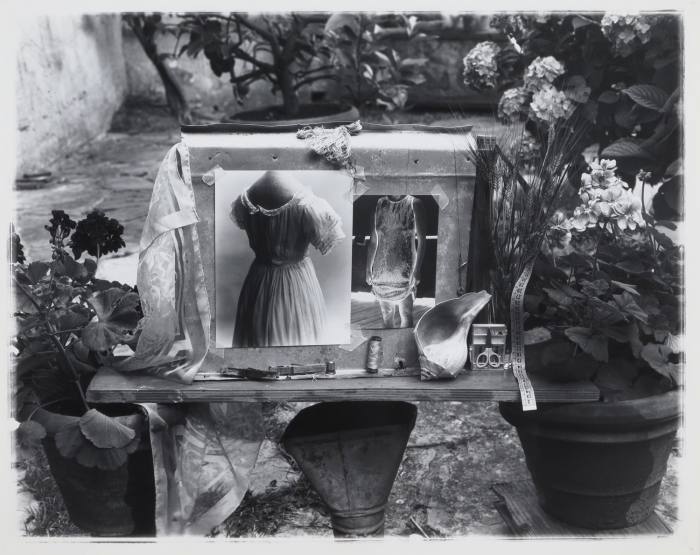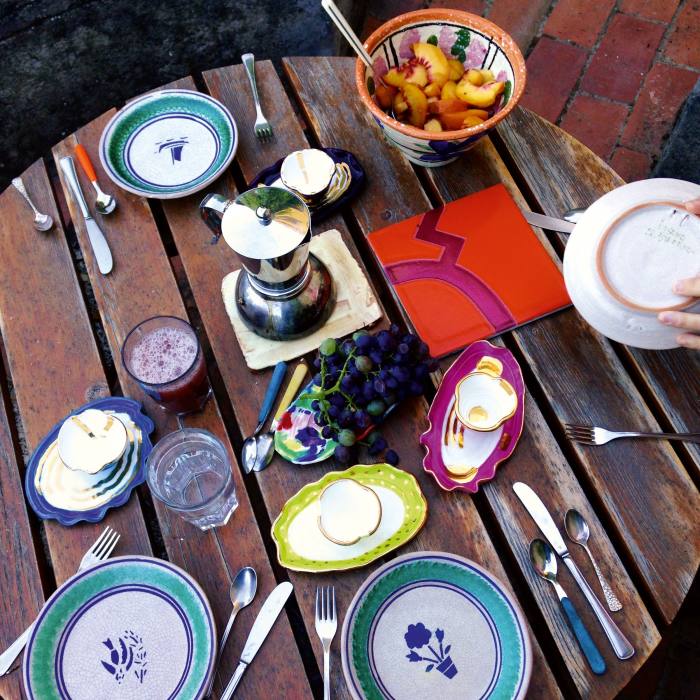When artist Betty Woodman died in 2018 aged 87, a booklet was handed out at her memorial containing some of her most treasured recipes. It was an apt tribute to an artist who started off making dinner sets and decorative pottery, became known for pushing the boundaries of ceramics and was also an accomplished cook. Together with her artist husband George, who died in 2017, she was remembered in the foreword as a naturally gracious host for whom “preparing meals for family and friends and sharing them on a beautifully adorned table remained a lifelong creative act and fundamental pleasure”.


One of the recipes included was for the couscous pancakes Betty made for brunch at her apartment in New York when the curator of the Metropolitan Museum came to offer her a retrospective in 2006, making her the first living female artist to receive that honour. There were also recipes for chermoula for fish, poisson à la marocaine, Turkish eggplant “ratatouille” and cucumber soup, a favourite of her son Charles, now an electronic artist. He remembers eating it with walnuts (“cool and inviting on a hot summer’s day”) at their farmhouse in Antella near Florence, where the Woodmans escaped for months at a time from their homes in Boulder, Colorado, and, later, New York. Their daughter Francesca, a photographer whose posthumous fame has near eclipsed that of her parents (she died by suicide in 1981 aged 22), would also join them and later visited on her own; a number of her haunting photographs were taken at Antella.
Described by George as an “artist residency for two”, the small stone farmhouse in the Tuscan hills was a place where art and life (and food especially) merged. The same could be said of Bloomsbury artists Vanessa Bell and Duncan Grant at Charleston in Sussex, where the dining table and conversations around it were as important to the ethos as any work produced in the studio. It is fitting, then, that Charleston will play host next month to the first UK exhibition dedicated to Betty and George and the impact that life at Antella had on their work.


Long before they bought the farmhouse in Antella in 1968, Italy had a profound effect. On visits from the ’50s onwards, Betty took inspiration from Etruscan pots and George, whose early output consisted mainly of paintings, drew on Italian landscapes and mosaics. In Antella, Betty set up a studio in the farmhouse and began experimenting with earthenware (a more sculptural medium than her usual stoneware). She and George also created work for a domestic setting, including splashback tiles for the kitchen. Over the years, Betty’s ceramics became increasingly sculptural – her Aragosta Soup Tureen (1980) is considered a transitional work that could still technically be used. But in daily life at Antella, her creations continued to serve a purpose. Flowers were arranged in her vases and food eaten off her plates.


Meals were, in fact, essential to their daily working ritual. Days at Antella began with breakfast in the nook – a small circular space on the side of the building that used to be a brick oven. Its dome had been removed and a round table installed with pillows. Having breakfast there was, recalls curator Katarina Jerinic of the Woodman Family Foundation, “a well-orchestrated performance”. There was macedonia di frutta (Italian fruit salad) with ricotta or yoghurt (made by George), plus bread (sometimes also made by George) and jams (made by Betty using fruit from the farm). A toaster was brought out on an extension lead. And Betty whipped up cappuccinos at the table. Guests looked out on views of the Duomo in Florence.
After breakfast, Betty and George retreated to their studios but they always broke for lunch, tea (usually cake or ice cream from the local gelateria) and dinner, which took place on the terrace around 9pm, “which was not very American”, notes Jerinic. Stopping what they were doing and sitting down to a meal was important not just for the food or conversation, but also for the aesthetic experience. Under Betty’s direction, the tables became colourful still lifes. “I took for granted that all the platters should be arranged like works of art and the tablecloths curated,” says Charles.


Of course, there was also amazing produce to eat, including fruit and vegetables from the garden. These included lemons, apricots, pears, figs and various types of tomatoes. “I remember one August visit, there was a huge bounty of tomatoes, five or six varieties,” Jerinic says. “Betty sliced them up, put them on different platters and we had to decide which were the best.” These tomatoes were dressed in fruity, peppery olive oil made using olives from their own grove. Most years, Betty and George returned to the US before the harvest. “So a few weeks after their return,” Jerinic recalls, “a big shipment would arrive filled with apricot jam, olive oil and dried mint, because they also grew mint, which made the most incredible tea.”
While Betty took the lead in the kitchen, George was no slouch. At one point the Woodmans installed a grill on the terrace – not a charcoal grill but one fired by propane, which “was considered very wild and experimental in Italy”, Charles recalls. George would grill meat, shrimp and chicken.
Perhaps the most obvious influence of meals at Antella on Betty’s work can be found in The Kitchen Table (2014), an installation that mimics the arrangement of dishes on a table. It was part of a group of works that marked her continued interest in the domestic. “The domestic object is something I have always been in love with,” she said in 2017, “but while the older works were actual teapots, boilers or casseroles, my new works are paintings that incorporate teapots or casseroles as illusions of a subject matter.”

Betty always fought against the hierarchies that separated craft from art and never disavowed the kitchen table as a nexus of creativity. “I was not a militant feminist,” she remarked, “but the issues raised by my work were. For me, it was not just about making the work – it was about using it. It was as much about putting the food on the table in those dishes as it was about making the dishes.” Being a good cook, she also noted, made her a better artist.
Betty Woodman and George Woodman is at Charleston, East Sussex, 25 March to 10 September, charleston.org.uk
Cucumber soup
(from Julia Child via Barbara Karoff & Min’s Kitchen)
Serves 6–8
-
Cook for 20 minutes or until cucumbers are soft. Put through food mill and cool.
-
Stir in one cup of sour cream.
-
Serve hot or cold – especially good cold.
Couscous pancakes
-
Place 1/4 cup of couscous in pan with 1/2 cup boiling water. Cover and let sit for about 10 minutes.
-
Beat two eggs well. Add one cup of yoghurt and continue beating. Add two heaping tablespoons of ricotta, beat. Add one teaspoon baking soda, one teaspoon baking powder and a pinch of salt. Then add couscous, one tablespoon of cornmeal (if you have it), and a heaping 1/4 cup of flour. Beat just until mixed. (Optional: stir in blueberries, raspberries, etc.) Cook on griddle.
-
You can substitute leftover rice for couscous.
-
If you beat the egg whites separately and fold them in at the end, the pancakes are light and fluffy.
Stay connected with us on social media platform for instant update click here to join our Twitter, & Facebook
We are now on Telegram. Click here to join our channel (@TechiUpdate) and stay updated with the latest Technology headlines.
For all the latest Art-Culture News Click Here

